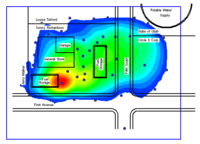GMS:2D Scatter Point Set Creation and Editing: Difference between revisions
From XMS Wiki
Jump to navigationJump to search
No edit summary |
|||
| (10 intermediate revisions by the same user not shown) | |||
| Line 2: | Line 2: | ||
Each of the points from which values are interpolated are called scatter points. A group of scatter points is called a scatter point set. Each of the scatter points is defined by a set of xy coordinates. | Each of the points from which values are interpolated are called scatter points. A group of scatter points is called a scatter point set. Each of the scatter points is defined by a set of xy coordinates. | ||
Each scatter point set has a list of scalar | Each scatter point set has a list of scalar datasets. Each dataset represents a set of values which can be interpolated to a TIN, mesh, or grid. | ||
Multiple scatter point sets can exist at one time in memory. One of the scatter point sets is always designated as the "active" scatter point set. Interpolation is performed from the active | Multiple scatter point sets can exist at one time in memory. One of the scatter point sets is always designated as the "active" scatter point set. Interpolation is performed from the active dataset of the active scatter point set only. | ||
===Creating Scatter Points=== | ===Creating Scatter Points=== | ||
| Line 10: | Line 10: | ||
===Interactively Creating Scatter Points=== | ===Interactively Creating Scatter Points=== | ||
The Create scatter point tool is used to click out new scatter points in the GMS Graphics Window. The new scatter points are added to the active scatter point set. If | The '''Create scatter point''' tool is used to click out new scatter points in the GMS Graphics Window. The new scatter points are added to the active scatter point set. If wanting the new points in their own scatter point set, select the ''Scatter Points'' | '''New Scatter Point Set''' command. | ||
===Converting from Other Types=== | ===Converting from Other Types=== | ||
Scatter point sets are often created by converting from other data types (TINs, meshes, grids, boreholes). The following commands are available to convert an object to a | Scatter point sets are often created by converting from other data types (TINs, meshes, grids, boreholes). The following commands are available to convert an object to a scatter point set: | ||
*[[GMS:TIN Module#Converting TINS to Other Data Types|TIN → 2D Scatter_Points]] | *[[GMS:TIN Module#Converting TINS to Other Data Types|TIN → 2D Scatter_Points]] | ||
| Line 23: | Line 23: | ||
*[[GMS:2D Grid Module#Converting 2D Grids|Grid → 2D Scatter Points]] | *[[GMS:2D Grid Module#Converting 2D Grids|Grid → 2D Scatter Points]] | ||
*[[GMS: | *[[GMS:Converting a 2D Mesh to Other Types of Data|Mesh → 2D Scatter_Points]] | ||
*[[GMS:Map to Modules#Map to 2D Scatter Points|Map → 2D Scatter Points]] | *[[GMS:Map to Modules#Map to 2D Scatter Points|Map → 2D Scatter Points]] | ||
| Line 30: | Line 30: | ||
===Importing Tabular Scatter Point Data=== | ===Importing Tabular Scatter Point Data=== | ||
In most cases, scatter point sets are created by importing a text file through the [[GMS:File Import Wizard|File Import Wizard]]. | In most cases, scatter point sets are created by importing a text file through the [[GMS:File Import Wizard|''File Import Wizard'']]. | ||
===Editing Scatter Points=== | ===Editing Scatter Points=== | ||
The location of a scatter point can be edited by selecting the scatter point and dragging it to a new location or by typing in the new coordinates in the [[GMS:The GMS | The location of a scatter point can be edited by selecting the scatter point and dragging it to a new location or by typing in the new coordinates in the [[GMS:The GMS Window|''Edit Window'']]. | ||
The | The dataset value associated with a scatter point can be edited using the edit field labeled "F:" in the [[GMS:The GMS Window|''Edit Window'']]. Dataset values can also be edited using a spreadsheet dialog by selecting the '''Edit Values''' button in the [[GMS:Datasets#Dataset Info|''Dataset Info'']] dialog. | ||
In addition to the dataset values, each scatter point has three properties that can be edited on a point by point basis: | In addition to the dataset values, each scatter point has three properties that can be edited on a point by point basis: | ||
| Line 51: | Line 51: | ||
The fixed [[GMS:Pilot Points|pilot point]] property is used with PEST(See [[GMS:Automated Parameter Estimation|Automated Parameter Estimation]]). If this option is on, then the value at this point is not estimated during the parameter estimation process. | The fixed [[GMS:Pilot Points|pilot point]] property is used with PEST(See [[GMS:Automated Parameter Estimation|Automated Parameter Estimation]]). If this option is on, then the value at this point is not estimated during the parameter estimation process. | ||
The scatter point properties can be edited by | The scatter point properties can be edited by double-clicking on a point or by selecting a set of points and selecting the '''Properties''' command in the ''Edit'' menu. | ||
=== | ===Deleting Scatter Points=== | ||
Individual scatter points can also be deleted. This command results in the removal of the point from all the datasets associated to the scatter point set. | Individual scatter points can also be deleted. This command results in the removal of the point from all the datasets associated to the scatter point set. | ||
| Line 59: | Line 59: | ||
{{Navbox GMS}} | {{Navbox GMS}} | ||
[[Category:2D Scatter Point]] | [[Category:2D Scatter Point|Create]] | ||
